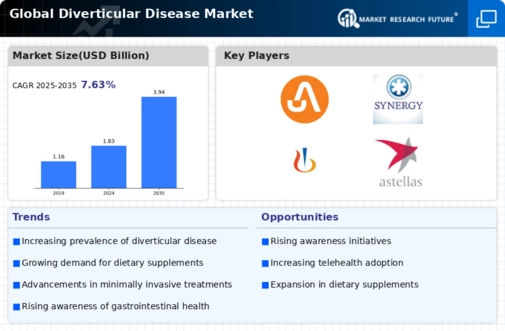Market Growth Projections
The Global Diverticular Disease Market Industry is projected to experience substantial growth over the next decade. With a market value of 1.83 USD Billion in 2024, it is anticipated to reach 3.94 USD Billion by 2035, reflecting a compound annual growth rate of 7.22% from 2025 to 2035. This growth trajectory indicates a robust demand for healthcare services and interventions related to diverticular disease. Factors contributing to this expansion include the rising prevalence of the disease, advancements in diagnostic and treatment options, and increased healthcare expenditure. Such projections highlight the importance of strategic planning and investment in the healthcare sector.
Rising Healthcare Expenditure
The Global Diverticular Disease Market Industry is positively impacted by the rising healthcare expenditure across various regions. Governments and private sectors are increasingly investing in healthcare infrastructure and services, which enhances access to treatment for diverticular disease. This trend is particularly evident in developed nations, where healthcare budgets are expanding to accommodate the growing burden of chronic diseases. As healthcare spending rises, it is anticipated that the market will experience robust growth, with a projected CAGR of 7.22% from 2025 to 2035. This financial commitment underscores the importance of addressing diverticular disease within broader healthcare strategies.
Growing Awareness and Education
Increasing awareness and education regarding diverticular disease are pivotal drivers of the Global Diverticular Disease Market Industry. Public health campaigns and educational initiatives have been instrumental in informing individuals about the risk factors and symptoms associated with the condition. This heightened awareness encourages early diagnosis and treatment, ultimately leading to better health outcomes. Healthcare professionals are also becoming more knowledgeable about the disease, which may contribute to improved patient management. As awareness continues to grow, the market is likely to see an uptick in demand for therapeutic options and preventive measures.
Advancements in Diagnostic Techniques
Technological innovations in diagnostic methods are significantly influencing the Global Diverticular Disease Market Industry. Enhanced imaging techniques, such as high-resolution CT scans and MRI, allow for more accurate detection and assessment of diverticular disease. These advancements facilitate timely diagnosis, which is crucial for effective management and treatment. As healthcare providers increasingly adopt these technologies, the market is expected to benefit from improved patient outcomes and reduced healthcare costs. The integration of artificial intelligence in diagnostics may further streamline processes, potentially increasing market growth as more patients receive appropriate care.
Rising Prevalence of Diverticular Disease
The Global Diverticular Disease Market Industry is experiencing a notable increase in prevalence, particularly among aging populations. As individuals age, the risk of developing diverticular disease escalates, leading to a higher demand for treatment options. In 2024, the market is projected to reach 1.83 USD Billion, reflecting the growing need for healthcare services and interventions. This trend is likely to continue as the global population ages, with estimates suggesting that by 2035, the market could expand to 3.94 USD Billion. Such growth underscores the importance of addressing diverticular disease in public health initiatives.
Increased Research and Development Activities
The Global Diverticular Disease Market Industry is witnessing a surge in research and development activities aimed at understanding the disease better and developing innovative treatment options. Pharmaceutical companies and research institutions are focusing on creating new therapies and improving existing ones, which could lead to more effective management of diverticular disease. This emphasis on R&D is likely to result in the introduction of novel medications and interventions, thereby expanding the market. As the understanding of diverticular disease evolves, it is expected that the market will continue to grow, driven by advancements in treatment methodologies.














